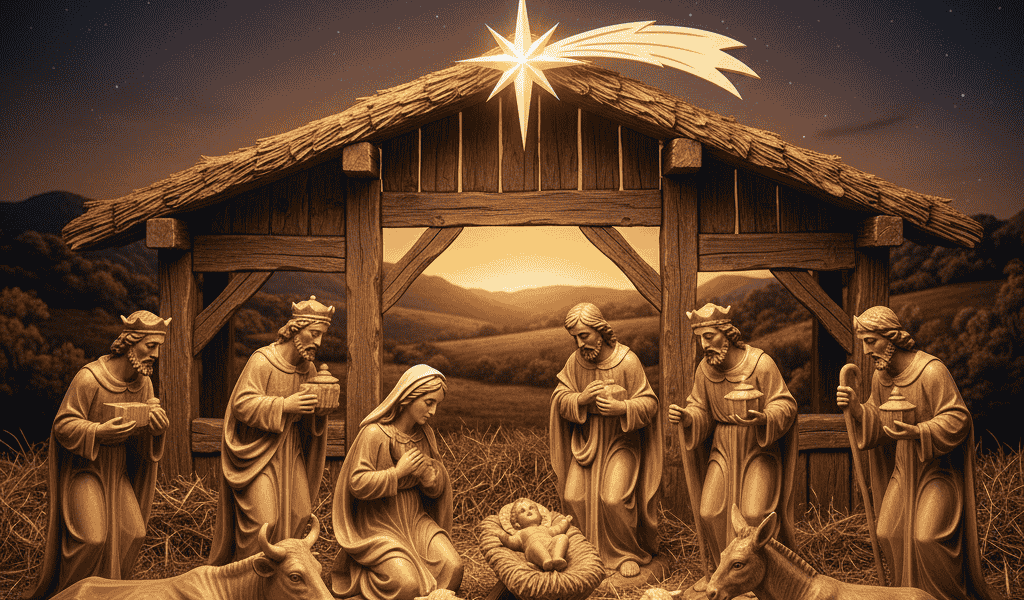The word “Nativität” may sound unfamiliar to many, but it carries a profound depth of meaning that resonates across cultures, disciplines, and centuries. Derived from the Latin term nativitas, meaning “birth,” Nativität represents the very essence of beginnings, creation, and new life. While often associated with the Christian tradition of Christ’s birth, its significance extends far beyond a single religious event, weaving through art, music, astrology, and even philosophy.
This comprehensive guide explores the multifaceted nature of Nativität, tracing its historical roots and examining its impact on global traditions. By understanding its origins and diverse applications, we can appreciate why this powerful concept continues to fascinate and inspire, serving as a timeless symbol of hope, renewal, and the universal miracle of birth.
The Historical Roots of Nativität
To fully grasp the meaning of Nativität, we must first look at its linguistic journey. The term originates from the Latin word nativitas, which directly translates to “birth” or “the act of being born.” The Latin root natus (“born”) is the foundation for many familiar words in English, including “nativity,” “native,” and “nature.”
As languages evolved, nativitas was adopted into German as “Nativität,” retaining its core meaning but also acquiring broader cultural and symbolic applications. While its English counterpart, “nativity,” is almost exclusively used to describe the birth of Jesus Christ, the German Nativität encompasses a wider range of beginnings. It can refer to any significant birth, whether literal or metaphorical. Including the birth of a person, an idea, a movement, or a creative work. This linguistic distinction is crucial, as it allows Nativität to bridge the tangible act of birth with abstract concepts of creation, origin, and destiny.
The Religious Heart of Nativität
In the realm of religion, Nativität holds its most widely recognized significance, primarily within Christianity. It refers to the Nativity of Jesus Christ (Nativität Christi), an event that stands as a cornerstone of Christian theology and a pivotal moment in human history for believers.
The Nativity of Christ
The celebration of Christ’s birth is more than just a historical commemoration; it is a profound symbol of hope, divine love, and salvation. According to Christian doctrine, the Nativität signifies the Incarnation—the moment God became human in the form of Jesus. This event, detailed in the Gospels of Matthew and Luke, tells the story of Mary and Joseph’s journey to Bethlehem, the humble manger, the guiding star, and the adoration of shepherds and Magi.
The tradition of celebrating the Nativität on December 25th dates back to the 4th century. The date was strategically chosen, likely to replace pagan winter solstice festivals with a significant Christian observance, thereby integrating the new faith into existing cultural rhythms.
Universal Symbols in the Nativität Story
Every element within the traditional Nativität narrative is imbued with deep symbolic meaning, contributing to its universal appeal:
- Baby Jesus: Represents divine incarnation, salvation, and the promise of new hope for humanity.
- Mary: Symbolizes purity, unwavering devotion, and the sacredness of motherhood.
- Joseph: Stands for protection, faith, and righteous fatherhood.
- The Manger: A symbol of humility and the idea that greatness can emerge from the most modest beginnings.
- The Star of Bethlehem: Represents divine guidance, enlightenment, and the light that leads believers to faith.
- The Shepherds: Symbolize humanity and the ordinary people who were the first to witness the divine event.
- The Magi (Wise Men): Represent wisdom, the diversity of humanity, and the spiritual quest to find truth.
These symbols have allowed the Nativität story to transcend its specific religious context, resonating with universal themes of hope, humility, and renewal.
Cultural Celebrations Across the Globe
The story of Nativität has inspired a rich tapestry of cultural traditions around the world. While centered on the same narrative, each culture has infused its celebrations with unique local customs, creating a diverse and vibrant global observance.
- Italy: In Italy, the Presepe is a central Christmas tradition. These are elaborate nativity scenes, often handcrafted with meticulous detail, that go far beyond the basic figures. Entire miniature villages are created, blending the sacred story with scenes of everyday Italian life.
- Germany: The German Krippe holds a special place in holiday traditions. These wooden nativity sets are displayed in homes, churches, and public squares. Christmas markets often feature beautifully carved Krippenfiguren (nativity figures).
- Mexico: Las Posadas is a nine-day celebration leading up to Christmas. It involves nightly processions that reenact Mary and Joseph’s search for lodging (posada). The community participates by acting as innkeepers who initially turn them away before finally welcoming them in for celebration.
- Philippines: Known for having one of the longest Christmas seasons in the world, the Philippines celebrates Simbang Gabi, a series of pre-dawn masses held for nine days before Christmas. The Nativität is a central theme of these services.
- France: In the Provence region of France, nativity scenes feature unique clay figures called santons (“little saints”). These figurines represent not only the holy family but also a wide array of traditional Provençal villagers, such as the baker, the fisherman, and the mayor, creating a scene where the entire community comes to adore the newborn Christ.
Also Read: Generalraspberry8102: The Curious Fusion of Raspberry Pi Innovation and Digital Identity
Artistic and Musical Interpretations
For centuries, the Nativität has served as a powerful source of inspiration for artists and musicians. Who have sought to capture its spiritual depth and emotional resonance.
Depictions in Art
The Renaissance period saw a flourishing of Nativität art, as masters like Sandro Botticelli, Leonardo da Vinci, and Raphael blended divine symbolism with groundbreaking artistic techniques. Botticelli’s “Mystical Nativity” is a complex allegorical work that combines the joy of Christ’s birth with prophecies of his return. Later, Baroque artists like Caravaggio used dramatic lighting and intense emotion to convey the raw, human reality of the scene in works such as “Nativity with St. Francis and St. Lawrence.”. These artistic interpretations not only reflect religious devotion but also serve as a mirror to the evolving cultural and stylistic trends of their time.
Celebrations in Music
The story of Nativität has also been set to music in countless forms, from simple Christmas carols to grand oratorios. George Frideric Handel’s Messiah is perhaps the most famous musical work associated with the theme, with its prophecies and jubilant “Hallelujah” chorus. Countless hymns, such as “Silent Night” and “O Holy Night,” capture the quiet reverence and profound joy of the holy birth. Becoming an integral part of Christmas celebrations worldwide.
Modern Meanings and Relevance
While its historical and religious foundations remain strong, the concept of Nativität has continued to evolve, finding new relevance in modern contexts, including astrology and philosophy.
Nativität in Astrology
In astrology, Nativität refers to an individual’s birth chart, or natal chart—a celestial map of the planets and stars at the exact moment of their birth. In German, this is known as a Nativitätshoroskop. Astrologers believe this chart reveals a person’s character, potential, and life path. The renewed interest in astrology has brought the term Nativität to a new audience, connecting the moment of birth not just to a spiritual event but to a cosmic one. It speaks to the timeless human desire to find meaning in our origins and to understand our place in the universe.
Philosophical and Symbolic Meanings
Philosophers and writers have often used Nativität as a powerful metaphor for creation, identity, and transformation. It can represent the birth of an idea, the dawn of a new era, or a moment of profound spiritual or intellectual awakening. In existential thought, Nativität can symbolize the beginning of self-awareness—the point at which an individual recognizes their own existence and freedom. It also echoes the concept of rebirth, which is central to many spiritual traditions, representing renewal and the opportunity to start anew.
Why Nativität Endures
The enduring appeal of Nativität lies in its universal message. In a world often marked by complexity and uncertainty, the story of a humble birth that brought immense hope continues to resonate deeply. It reminds us of the power of new beginnings and the potential for light to emerge even in the darkest of times.
Whether viewed through a religious, cultural, artistic, or philosophical lens, Nativität symbolizes fundamental human values: hope, humility, love, and the promise of renewal. It encourages us to find wonder in the miracle of birth and to recognize the creative spark that exists in every new beginning. From ancient traditions to modern interpretations, the concept of Nativität remains a timeless and powerful symbol of our shared humanity.
FAQs
What does Nativität mean?
Nativität is derived from the Latin word “nativitas,” meaning birth or origin. It is a concept often associated with themes of creation, renewal, and the beginning of life.
Why is Nativität important in various cultures?
Nativität holds a significant place across cultures as it symbolizes hope, humility, and the miracle of new beginnings. It transcends religious and philosophical boundaries, connecting people to universal values of love and transformation.
How is Nativität celebrated in different traditions?
Throughout history, Nativität has been celebrated in diverse ways, such as through storytelling, music, ritual, and art. Each tradition offers unique interpretations while preserving the core essence of renewal and shared humanity.
Can Nativität have a personal meaning?
Absolutely. On a personal level, Nativität can represent any new beginning or creative spark in life. It serves as a reminder to cherish growth, possibility, and the enduring power of hope.
Conclusion
Nativität, in its many forms and interpretations, serves as a powerful symbol of renewal and creativity. Whether seen through the lens of cultural traditions or personal experiences. It reminds us of the beauty in new beginnings and the boundless potential of hope. By honoring and reflecting on Nativität, we can find inspiration to foster growth, resilience. And a deeper connection to both ourselves and the world around us.
Read More Topics on Usauptrend.co.uk




